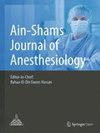Broken epidural catheter: individualize your management
IF 0.5
Q4 ANESTHESIOLOGY
引用次数: 0
Abstract
Epidural anaesthesia is one of the most used neuraxial anaesthesia techniques. It has been utilized as the principal anaesthesia modality involving lower limb surgery. Breakage of epidural catheters is an unusual occurrence whose subsequent therapy lacks uniformity due to the absence of a consensus and defined standards. A 39-year-old male with no comorbidities was scheduled for right lower limb reconstruction surgery due to non-union of the tibia. Combined spinal-epidural anaesthesia was planned. During epidural catheter insertion, there was difficulty threading the catheter, and upon its removal, a long segment of catheter (8 cm) was left inside the body. Following informed consent from the patient, the retained fragment was surgically extracted in the same sitting under general anaesthesia. Even when faced with such a circumstance, it is best to explore surgically and remove a long segment broken catheter to allay patient anxiety.硬膜外导管破裂:个体化处理
硬膜外麻醉是最常用的神经轴麻醉技术之一。它已被用作主要麻醉方式涉及下肢手术。硬膜外导管断裂是一种罕见的现象,由于缺乏共识和明确的标准,其后续治疗缺乏一致性。一名39岁男性,无合并症,因胫骨不愈合,计划进行右下肢重建手术。计划脊髓-硬膜外联合麻醉。在硬膜外置管过程中,导管穿线困难,取出导管后,在体内留下一长段(8cm)导管。经患者知情同意后,保留的碎片在全身麻醉下手术取出。即使遇到这样的情况,最好还是手术探查,取出长段断裂导管,以减轻患者的焦虑。
本文章由计算机程序翻译,如有差异,请以英文原文为准。
求助全文
约1分钟内获得全文
求助全文

 求助内容:
求助内容: 应助结果提醒方式:
应助结果提醒方式:


